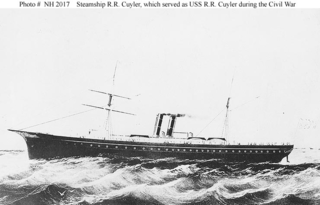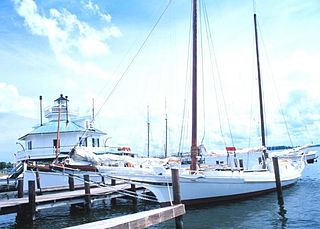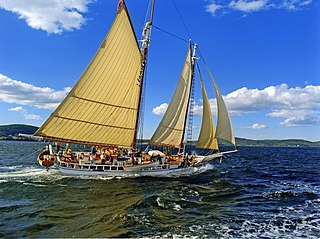
Alma is an 1891-built scow schooner, which is now preserved as a National Historic Landmark at the San Francisco Maritime National Historical Park in San Francisco, California.

Pearl hunting, also known as pearling, is the activity of recovering pearls from wild molluscs, usually oysters or mussels, in the sea or freshwater. Pearl hunting was prevalent in the Persian Gulf region and Japan for thousands of years. On the northern and north-western coast of Western Australia pearl diving began in the 1850s, and started in the Torres Strait Islands in the 1860s, where the term also covers diving for nacre or mother of pearl found in what were known as pearl shells.

USS R. R. Cuyler was a steamer in the United States Navy during the American Civil War. She was outfitted by the Union Navy as a gunboat and was assigned to the Union blockade of the Confederate States of America.

A.J. Meerwald, later known as Clyde A. Phillips, is a restored dredging oyster schooner, whose home port is in the Bivalve section of Commercial Township in Cumberland County, New Jersey. The schooner was added to the National Register of Historic Places on November 7, 1995 for her significance in architecture, commerce, and maritime history. She became the state tall ship in 1998. Today, A.J. Meerwald is used by the Bayshore Center at Bivalve for onboard educational programs in the Delaware Bay, and at other ports in the New Jersey, Pennsylvania, and Delaware region.

Governor Stone is a historic schooner, built in 1877, in Pascagoula, Mississippi. She is the only surviving two-masted coasting cargo schooner built on the Gulf Coast of the United States, and is only one of five such surviving US-built ships. On 4 December 1991, she was added to the US National Register of Historic Places. One year later, the schooner was designated a US National Historic Landmark. She is presently berthed at Saint Andrews Marina in Panama City, Florida, where she is maintained by a nonprofit group. Sailing tours are regularly scheduled.

The pungy is a type of schooner developed in and peculiar to the Chesapeake Bay region. The name is believed to derive from the Pungoteague region of Accomack County, Virginia, where the design was developed in the 1840s and 1850s.

The schooner J. & E. Riggin, a National Historic Landmark, was built on the Maurice River in Dorchester, New Jersey in 1927. She is one of a small number of surviving two-masted schooners, once one of the most common sailing ships in North American waters. Now based in Rockland, Maine, she serves as a "windjammer" offering sailing cruises to tourists.

The bugeye is a type of sailboat developed in the Chesapeake Bay for oyster dredging. The predecessor of the skipjack, it was superseded by the latter as oyster harvests dropped.

Priscilla is a classic oyster dredging sloop and museum ship at the Long Island Maritime Museum. Built in 1888, it is the oldest surviving boat from the Great South Bay oyster fleet, and was designated a National Historic Landmark in 2006. It is berthed near the Modesty, another National Historic Landmark sloop.

Isaac H. Evans, originally Boyd N. Sheppard, is a two-masted schooner berthed in Rockland, Maine. She is a Maine windjammer, serving the tourist trade. Built in 1886 in Mauricetown, New Jersey, she is the oldest of a small number of surviving oyster schooners, used in service of the oyster harvesting industry in the coastal waters of New Jersey. She was declared a National Historic Landmark in 1992.
Frolic was a Maryland State Oyster Police Force schooner, part of the force established to enforce state conservation laws designed to protect Maryland's oyster resources when out of state, often New England, dredgers began destroying reefs in the Chesapeake Bay. Later local opposition to licenses turned to open "warfare" in the "oyster wars" when a fleet of state vessels fought "oyster pirates" in armed conflicts. Frolic was built in 1884. The schooner was assigned to Queen Anne's County, Maryland in 1902 and later to the Commission's Second District which included Eastern Bay, and the Miles and Wye Rivers.
Active was a wooden ketch that was wrecked on 19 January 1898 on the Oyster Bank at the entrance of Newcastle Harbour, New South Wales, Australia, near the previously wrecked schooner Colonist while carrying a cargo of ironbark to Morpeth, New South Wales, under the command of Captain P. Williams. There were no casualties but the ship was lost. The wreck has not been located, but the approximate co-ordinates of the shipwreck are 32.92°S 151.79°E.

The Bivalve Oyster Packing Houses and Docks are located along Shell Road in the Bivalve section of Commercial Township in Cumberland County, New Jersey. They were added to the National Register of Historic Places on February 28, 1996, for their significance in commerce and maritime history during the years 1870–1945. The listing includes five contributing buildings. The buildings were listed as part of the Marine and Architectural Resources of the Maurice River Cove Multiple Property Documentation Form (MPDF). The Bayshore Center, an educational museum, is located adjacent to the property at 2800 High Street.

Julia Hamilton was a Maryland State Oyster Police Force schooner, part of the force established to enforce state conservation laws designed to protect Maryland's oyster resources when out of state, often New England, dredgers began destroying reefs in the Chesapeake Bay. Later local opposition to licenses turned to open "warfare" in the "oyster wars" when a fleet of state vessels fought "oyster pirates" in armed conflicts.
Bessie Jones was a Maryland State Oyster Police Force schooner, part of the force established to enforce state conservation laws designed to protect Maryland's oyster resources when out of state, often New England, dredgers began destroying reefs in the Chesapeake Bay. Later local opposition to licenses turned to open "warfare" in the "oyster wars" when a fleet of state vessels fought "oyster pirates" in armed conflicts. Bessie Jones was assigned to St. Mary's County, Maryland in 1902 and later to the Hill's Point, Maryland areas.
The Maggie S. Myers is an oyster schooner, built in 1893 reportedly at Bridgeton, New Jersey. She is 50-foot-long (15 m) and all the framing is of white oak. The rigging was removed in the 1940s, when the vessel was converted to power. She is maintained and used for oyster dredging on the waters of the Delaware Bay.

Sherman Zwicker is a wooden auxiliary fishing schooner built in 1942 at the Smith and Rhuland shipyard, Lunenburg, Nova Scotia. Influenced by the design of the famous Bluenose, Sherman Zwicker was built to fish the Grand Banks. The schooner was built for F. Homer Zwicker of Zwicker and Co. Officially christened in 1942, the F/V Sherman Zwicker is the last operable saltbank fishing vessel in existence.

The David Carll, was a 19th-century pilot boat, built in 1885 at the David Carll shipyard in City Island, New York. She was named in honor of David Carll, a well-known City Island shipbuilder. The David Carll, was considered to be among the fastest schooners in the fleet. She was built to replace the Mary E. Fish, that was run down and sank by the schooner Frank Harrington in 1885. She was one of the pilot boats that survived the Great Blizzard of 1888. The David Carll, was lost at sea in 1893.

Jacob Samson Ellis, was a 19th-century prominent shipbuilder in Tottenville, Staten Island. He had a large successful shipyard business for over thirty years, with a reputation for his skill in designing vessels. Ellis died in Tottenville in 1902. His son, Hampton C. Ellis, continued with the shipyard constructing boats through the 1920s.
















